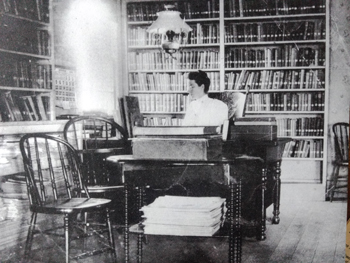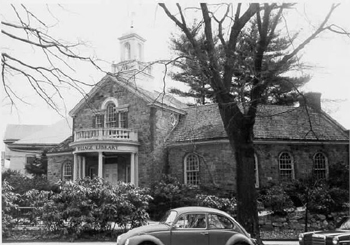Katonah is one of the three hamlets in the Town of Bedford in northern Westchester County, New York. The hamlet has an unusual history, and the Katonah Village Library has moved and changed with the community.
“Old Katonah” was the third settlement in this part of Westchester County in the first half of the nineteenth century, following the villages of Cherry Street and Whitlockville. The main streets of Old Katonah paralleled and crossed the railroad tracks where milk trains stopped to pick up produce for New York City sale.
The Katonah Village Improvement Society (then known as the Katonah Village Improvement Association) was organized on October 21, 1878. The intention of the founders was to involve the citizens in projects to add to the beauty and safety of the village. Planting trees, building wooden sidewalks, and installing kerosene streetlamps were early projects.

On December 10, 1880, the first Library and Reading Room was opened on Railroad Ave, with 400 books donated by Association members. In 1886 the Association incorporated and became the Katonah Village Improvement Society (K.V.I.S.).
Twice in the 1890s, the City of New York Water Supply condemned and purchased parcels of land upon which Old Katonah stood. New York City needed water, and the buildings of the village stood too close to the banks of the Croton and Cross rivers, which would be dammed for the creation of reservoirs. The members of the Katonah community wished to remain together, so they formed a syndicate and planned a new village on nearby land that would not be submerged. A street plan including wide boulevards and regular building lots was conceived, and members of the K.V.I.S. worked together to physically move more than 50 buildings from Old Katonah to New. The houses were drawn along soaped timber tracks by horsepower.

The planners of the new village kept a corner lot for their future library. In 1898 the library was temporarily moved from Old Katonah to 21 Edgemont Road (now an eatery/book store called The Reading Room) until enough money was raised to erect a new brick and stone building designed by architect Kerr Rainsford on the saved corner lot in the late 1920s. On December 5th 1930, the current Library (on the corner of the Parkway and Bedford) was dedicated. In 1951, the Katonah Village Library was officially granted an Absolute Charter by the Education Department of NY. In 1952, in order for the library’s staff to enroll in the State Pension Plan, the Library legally separated from the Katonah Village Improvement Society, and became incorporated as an Association Library. The Library went through several building renovations. In 1958, the Children’s Room on the lower level was added, in 1968 the building was expanded by Lester W Smith AIA, and in 1992, the lower level was remodeled.
Katonah Historical Museum
Katonah’s interesting history inspired local residents who want to keep the events of the past in focus for current and future residents. The Katonah Historical Museum opened in 1984 and now exhibits items of historical interest on the third floor of the Library. Additionally, on the ground floor of the library, through the “Children’s Room entrance”, an accurate diorama of a house on the move from Old Katonah to New Katonah can be found.
In 1985, thirty-eight residences, three churches, professional office buildings–as well as the Katonah Village Library–were added to the National Register of Historic Places.
Katonah Gallery/ Katonah Museum of Art
In 1954, a committee of the Katonah Village Improvement Society established a small art gallery in a single room on the upper floor of the Library building to display works by local artists. In 1956, the Katonah Gallery obtained a charter as an independent organization, and grew over the years into new space on the ground floor following the library expansion of the 1960s. The scope of Gallery exhibitions also expanded. In 1991, the prestigious organization became the Katonah Museum of Art and moved half a mile to their own new, architecturally outstanding building.